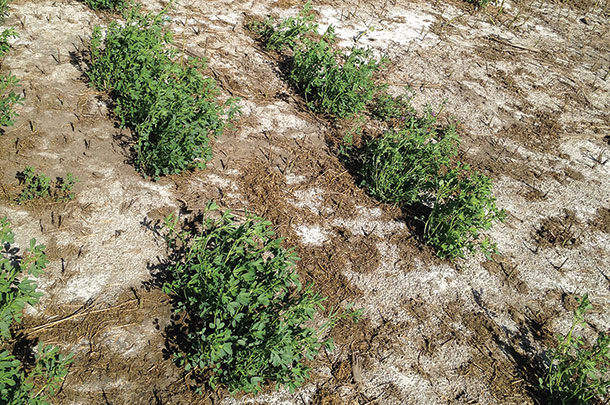However, new ways are being developed to mitigate soil salinity by developing alfalfa varieties that are increasingly salt-tolerant. These new varieties are designed to thrive in saline soils — a condition that will escalate in the future.
What is soil salinity?
Saline soils develop when irrigation water that is moderately high in salt is applied to crops in arid environments. In turn, this saline water evaporates, concentrating salts near the surface. Because of inadequate rainfall, these accumulated salts are unable to leach down through the soil profile.
In the Northern Plains, where soil salinity is not as pronounced as in the arid West, salts can still accumulate because of fluctuating water tables or low spots on the landscape. Soil salinity is particularly prevalent in areas of California, Texas, Nevada, Utah and Arizona.
“When you have salty soil, the salt clings to the soil particles and actually pulls moisture away,” says Peter Reisen, director of plant breeding at Forage Genetics International (FGI). “So you can have a field that is well-irrigated, and yet the plants look like they’re suffering from drought because they’re not able to access that water.”
Saline soil conditions are often accompanied by two other soil problems: high sodium content (sodic soils) and high soil pH (alkaline soils). Sodic conditions negatively affect soil structure and water penetration.

Alkaline soils are poor for plant growth, limiting the availability of key nutrients. The combination can compound stress on alfalfa plants, hampering crop establishment and production.
Soil salinity and alfalfa producers
Sharon Benes, a professor at California State University – Fresno, has conducted research on soil salinity in California, where the greater salinity problems for forage producers are found in the western San Joaquin Valley and in the Imperial Valley.
“As we have continuing irrigation water shortages in California, the higher-quality (less saline) waters will be used for the irrigation of trees and vines,” Benes says. “It is pretty apparent that more saline waters will be used for forage production.
With less surface water available for irrigation, many growers are using deeper groundwater for their irrigation water source. This generally means that more saline water is being applied to soils.”
Other water sources are being tapped, Benes says. “If a grower is using saline well waters, or in some cases, a municipal waste water with some salinity, then a soil salinity problem can develop. As is the water, so will be the soil, although water management practices such as leaching can be employed to reverse this trend.”
Benes stresses the importance of soil sampling so that growers can determine the exact level of salinity, and then make better soil and crop management decisions. “It’s important for growers to determine whether they have just a salinity problem or if they have saline-sodic soils, which means not only too much sodium but also not enough calcium,” she says.
“Sodicity can reduce the emergence of alfalfa plants and cause poor water infiltration and drainage through the soil profile.”
Current research on salt tolerance
An aggressive breeding effort began in 2010, evaluating and screening alfalfa plants for salt tolerance in actual field conditions. FGI uses three methods for testing new salt-tolerant alfalfa varieties:
1. Greenhouse testing: Salt germination tests are conducted, which measure alfalfa seed germination under moderately high salt conditions.
They also compare a new variety or breeding line to established tolerant and non-tolerant checks. A second test measures alfalfa plant growth and production potential using pure water versus salt water.
2. Field nurseries: The salt tolerance of various alfalfa varieties is tested through six nurseries in locations from Texas to Washington that typify saline soil stresses. Currently, there are more than 50,000 plants being evaluated for salt tolerance in these six environments.
Only the strong plants survive. If a nursery has 5,000 alfalfa plants, after two or three years that nursery may be down to 10 or 15 plants that are still vigorous and truly salt-tolerant.
Those are the plants that would be used as parents for a new variety. Our data also confirms that a variety will not only perform well under salt conditions, but will also thrive where saline is not a problem, as farmers’ soils are variable and not 100 percent saline.
3. Marker-assisted selection: Falling prices have made marker-assisted selection more appealing to alfalfa researchers. Leaf samples can be taken from plants in the greenhouse, and those genes that provide salt tolerance are then identified.
The outlook on soil salinity
“Anywhere that irrigation water is becoming limited, soil salinity is going to become a bigger and bigger problem,” Reisen says. “We’re going to see more of it in the High Plains and Central Plains, spreading down into Kansas, Oklahoma and Texas."
"In the West, current water demands are great due to lack of adequate winter precipitation, which is the source of most of our irrigation water. Lack of snow and rain is impacting aquifers, which results in wells drying up. We’re simply not getting the recharge that’s needed.”
“The development of salt-tolerant alfalfa varieties is vital for producers in our region,” Benes says. “It seems that drought is in our future. We may have some wet years ahead, but we’re going to continue to have very dry years. I think that the ability to grow alfalfa on more saline soils, or under irrigation with more saline water, will be critical for the future.” FG
PHOTO 1: Nursery in White Lake, South Dakota, shows alfalfa plants bred for winterhardiness and salt tolerance.
PHTOT 2: FGI salt nursery in Touchet, Washington, shows alfalfa plants not bred for salt tolerance grown in a heavy saline sodic soil with a pH close to 10.3 (far above a desirable 7.0 neutral pH). Photos courtesy of Jeremy Hayward.

-
Jeremy Hayward
- Brand Manager
- W-L Alfalfa
- Email Jeremy Hayward













